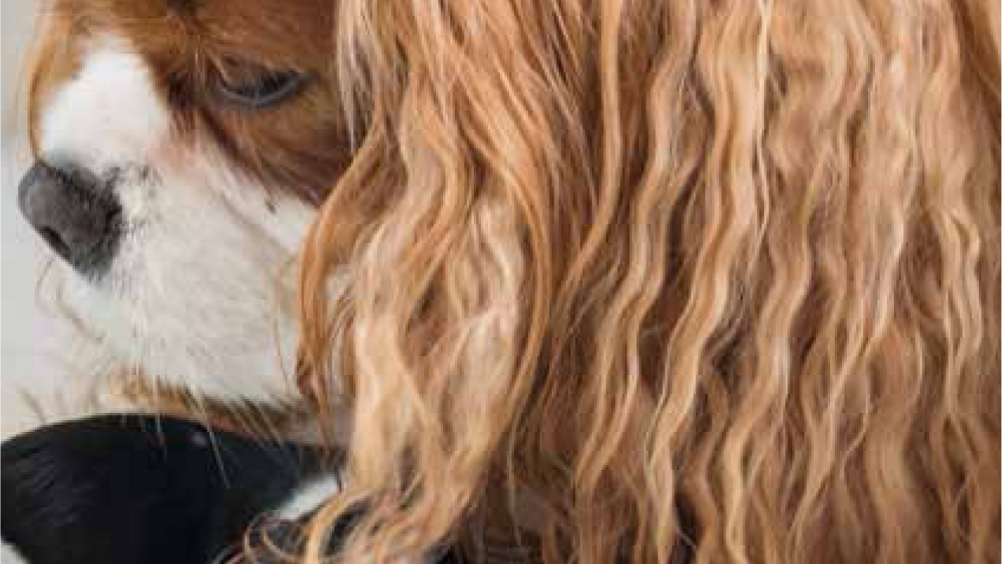Breeders breed for many reasons. However, whatever the motivation, most dogs bred will become pets in a home. Conscientious dog breeders want healthy dogs and aim to produce puppies that are free from hereditary medical conditions. Less well recognised is the fact that dogs need to be behaviourally healthy too and that breeders play an essential role in producing behaviourally or temperamentally sound puppies (Czerwinski et al, 2016). Good genes and early life experiences (up to 8 weeks) are most important to behavioural development in dogs, and this is in the hands of the breeder.
While caregivers are often blamed for their dogs' behavioural issues, the dogs may be victims of poor breeding practices/environments that failed to prepare them for life as pets in a home (Foyer et al, 2016). The UK Government has recognised this and is currently developing a range of proposals (UK Government, 2017) aimed at improving the welfare of the nation's puppies and their suitability as pets. However, this could be extended further by producing a code of recommendations for the rearing of puppies, designed, in part, to ensure both the physical and behavioural health of puppies bred. In the meantime, there is a need for informed discussion as to what makes a behaviourally aware breeder.
Genetics and the breeding bitch
Gene selection has long been exploited by breeders to produce particular physical (e.g. bracychephalic breeds) and behavioural (e.g. herding breeds) phenotypes. However, there is growing awareness among scientists that puppies may inherit undesirable behavioural traits that affect their behavioural suitability as pets. Among others, these unwanted traits may include:
- Increased noise sensitivity; for example, the gene for sound sensitivity in Border Collies has been identified (Overall, 2014)
- Nervousness (Scott and Fuller, 1965; Goddard and Beilharz, 1985; Serpell and Jagoe, 1995Overall et al, 2014)
- Increased anxiety and stress when presented with novel environmental stimuli (Scott and Fuller 1965; Goddard and Beilharz, 1985; Serpell and Jagoe, 1995; Overall et al, 2014)
- Human-directed aggression (Liinamo et al, 2007)
- Dog-directed aggression (Liinamo et al, 2007)
- Obsessive-compulsive disorder (Schiefele et al, 2016).
Thus, it is important that the RVN can encourage would-be breeders to think critically and objectively about the parent stock and breed line that they propose to breed from. Some traits will have a particularly high heritability, for example nervousness, which means that the contribution that genes have made to the expression of the behaviour is much higher than the dog's subsequent life experiences. Many would-be breeders will not have access to the level of information needed to find out about wider expression of negative behaviours in the breed line, and an impartial, objective, and critical evaluation of the bitch; and, the would-be stud dog's temperament and behavioural soundness is even more essential. Direct the would-be breeder to take advice from behavioural specialists with experience of canine breeding if necessary. Breeding for behaviourally sound dogs must start with breeding with good genes for optimal success (Czerwinsk et al, 2016).
Environment, the pregnant bitch and the developing fetus
Breeders also influence environmental factors which have a great impact on the dogs' future behaviour (Arhanta et al, 2010), and these include both before and after the puppies are born, so advising clients appropriately needs to go beyond just advising clients to breed from dogs with the ‘right’ temperament. It is known that petting and fussing over the pregnant bitch results in offspring that are more relaxed and resistant to stress (Fox, 1972; Dehasse, 1994; Bourdin, 1999). Conversely, there is a wide body of evidence across species (Merlot et al, 2013; Serpell et al, 2017) to suggest that mothers that experience excessive/chronic psychological or physiological stress and trauma during pregnancy produce progeny that are more reactive (Serpell and Jagoe, 1995) and fearful (Scherrer et al, 2000), and evince increased impulsivity and increased risk of psychiatric illness (Wadhwa et al, 2011). However, not all stress is bad, and it is important to remember the adaptive purpose of a physiological stress response is to promote survival during flight or fight situations (Dhabhar, 2014).
With this information in mind, the RVN should consider giving clients who have decided to breed the following prenatal tips for improved behavioural wellbeing of the puppies:
- Consider the temperament of the bitch; and, choose only a bitch that is confident rather than one that is fearful, easily over stressed, anxious or aggressive.
- Keep the bitch in a familiar environment during pregnancy. A change in environment during pregnancy can cause psychological stress to a pregnant bitch, which in turn can lead to behavioural and developmental problems with the puppies (Takahashi and Kalin, 1991). Avoid moving to a new house, making major changes to the home, or introducing another pet or animal into the social group during the dam's pregnancy.
- Be emotionally available for the bitch. Cuddles and affection in a bitch that wants this will help to buffer any effects of negative stressors.
- Avoid starting training programmes designed to reduce fear/anxiety to known stressors. Pregnancy is not the time to undertake this. Resolve problems before pregnancy (or do not breed from her).
- Be mindful that nutritional stress can also have lasting behavioural effects (Greco, 2014; Lindsay et al, 2018)
- Avoid sudden changes in temperatures. A sudden change in body temperature, for example, by going swimming in cold water, may cause physiological stress. Research in other mammals suggests that this may cause abnormalities such as cleft palette and may also lead to puppies that are behaviourally abnormal (Huizink et al, 2004).
- The pregnant bitch should be exercised as normal, unless there is a medical reason not to, as this provides her with mental and physical stimulation. Depriving her of this may cause increased stress and boredom. However, busy locations such as dog shows and parks should be avoided. As the pregnancy progresses, she should be allowed to decide for herself how far she walks.
- Be aware of unexpected single event fearful responses, as these may have a detrimental effect on the behavioural development of the puppies; for example, if the bitch is sound sensitive to fireworks, then it would be sensible to avoid her being pregnant during Guy Fawkes season or at New Year when she is likely to be exposed to noises that concern her.
- Avoid the use of oral steroids or breeding from bitches on long-term oral steroids. Adult dogs on steroid medication show increased anxiety and fear-associated behaviours, reduced play, and increased human avoidance (Notari et al, 2015).
- Transplacental transfer of cortisol might pre-dispose the puppies as adults to behavioural disorders relating to stress and anxiety, as has been shown experimentally in rats (Thompson, 1957) and humans (Glover, 2015). Although intra-uterine environmental stress and the transfer of cortisol has not been studied formally in dogs, there is no reason to think that it works any differently in dogs than in humans or rodents. When a dam is exposed to extremely high levels of stress, the enzymes that inactivate cortisol at the placenta switch off and the developing fetuses receive cortisol in order to prepare them for a stressful environment; however, the resulting pups are more likely to be easily alarmed and reactive.
- Consider the environment of the stud dog. Is it optimal for stud dog behavioural wellness and sperm quality. Remember this dog will contribute, on average, 50% of the genetic material (Schagdarsurengin and Steger, 2016).
Neonatal period — from birth to 13 days of age, when the puppies' eyes open
Puppies require nurturing, and Jagoe (1994) noted that pups that were hand reared, orphaned, or born by Caesarean section and subsequently rejected by their dams were more likely to develop behavioural issues associated with anxiety and stress (Figure 1). Fox (1978) wrote that at this time the puppy is compelled to seek contact comfort and suckling. Foyer et al's (2016) research suggested that the level of maternal care has a profound effect on behavioural development in dogs; and they suggested that breeders evaluate maternal behaviour in bitches before breeding.
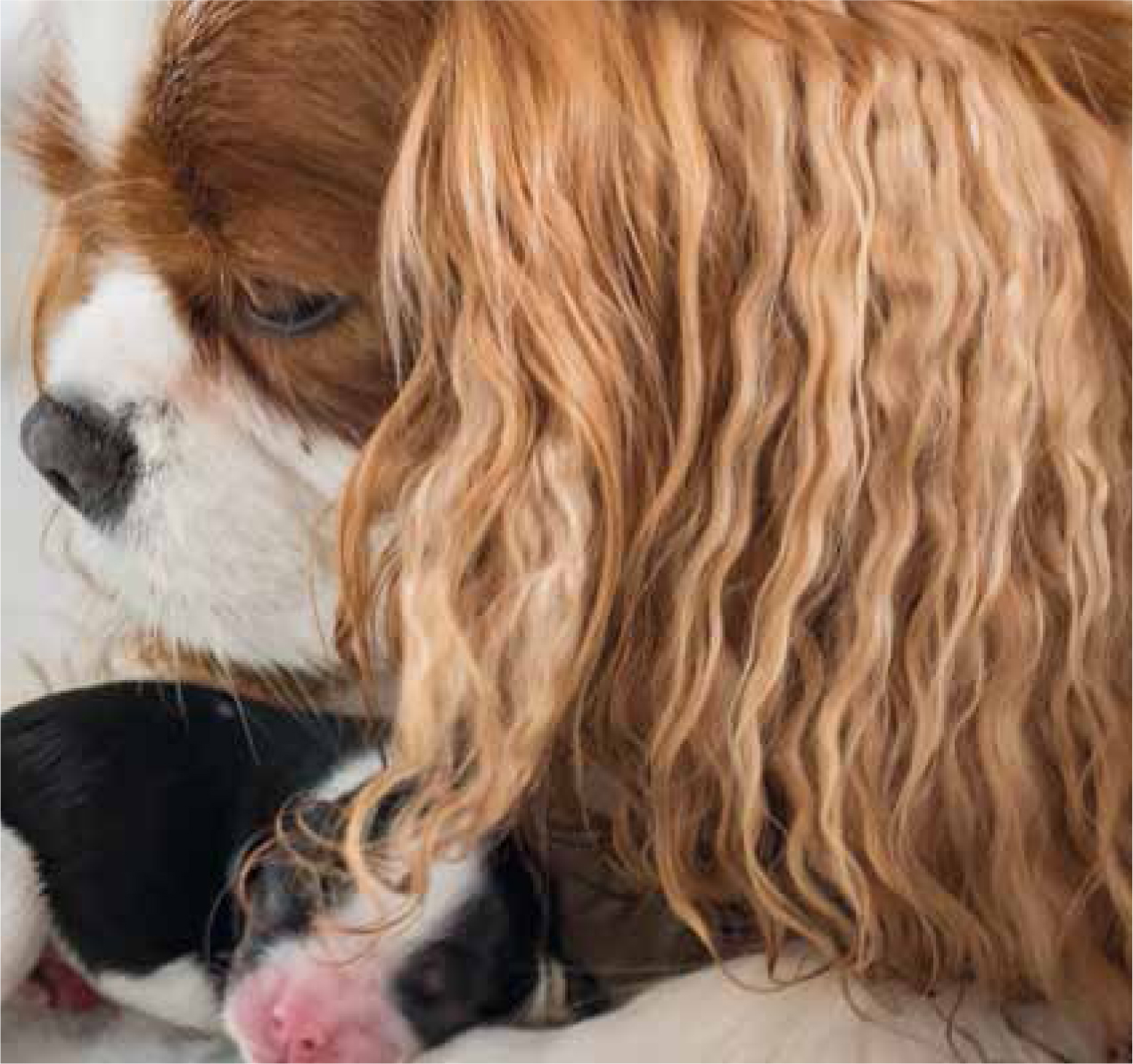
Many breeders are understandably concerned with hygiene and the physical health of the puppies and have no desire to expose these puppies to any potential infection. RVNs can encourage breeders to provide a behaviourally optimum environment with little risk to the physical health of the puppies by suggesting the following measures:
- The use of scent cloths — the puppy is capable of learning the sense of olfaction (Fox 1971) and tactile (Fox and Stelzner, 1966; Bacon and Stanley, 1970) associations. Using these senses, puppies can be socialised to humans and other species before their eyes are open and before they can leave the nest (Appleby, personal communication). Neonatal puppies can begin to be socialised to a range of people (e.g. children, men, women, old and young), as well as to other species (e.g. dogs, cats, parrots, sheep, etc.) through scent and without increased vulnerability to infection. Breeders should be advised to purchase new cloths and boil wash without detergent and line dry before use.
- Following a Caesarean section — puppies should be kept close to the bitch so that they can smell her with the addition of a comforting teddy to snuggle against for warmth and security. If it is possible, prior to the Caesarean section, the dam's scent should be transferred to a scent cloth or the teddy. As soon as possible, the puppies should be returned to their dam to be nurtured and fed by her.
- Puppy rejection or death of the dam — Battaglia (2009) suggested that puppies that are not able to suckle are more likely to develop an oral fixation and suckling of inappropriate items as adults. To overcome this, provide the hand-reared puppies with silicone teats or dummies to suck on. However, when possible, seek a surrogate dam. There are many social media groups for breeders and some offer a surrogate dam matching service. Before considering a surrogate dam, breeders should ensure that the surrogate dam is of good temperament, up to date with vaccinations, worming protocols, and is an experienced dam. Of further consideration should be the age of her existing puppies, if there are any, as it would be beneficial if the pups to be looked after are of a similar age and size. If it is not possible to find a surrogate dam, then the breeder will have no choice but to hand feed the puppies by bottle, sponge or syringe. Advice on how to do this safely can be given by RVNs to the breeders.
- Gentling — the puppies should receive regular handling from the breeder at a time that does not cause stress to the dam. This not only familiarises the puppy with human scent, but also creates mild stress which facilitates the socialisation process. This mild stress helps to produce puppies that can cope with stress and isolation, and that demonstrate increased learning capacity as adults (Appleby and Pluijmakers, 2004).
- Feeding the dam — it is important to feed the dam a protein rich, quality diet. Protein deficiencies in milk may result in impaired brain development and result in adult dogs that display hyper-arousal, impulsivity, and genuine hyper-kinesis (Bray et al, 2016). When presented with a litter size of more than six puppies, or an individual that is smaller or weaker than the others, the breeders should be advised by RVNs on how to adequately care for the runt. This may include placing the puppy on one of the larger teats or providing additional feeding.
- The importance of worming the dam — most owners and breeders know they should worm their dogs regularly with adequate worming preparations obtained from a veterinary surgeon. However, few breeders understand the importance of worming and its effect on the puppies' behavioural development. Prenatal infection of Toxocara canis can occur by larvae crossing the placenta into the unborn pups, and both T. canis and Toxascaris leonina can pass to the pups through the dam's milk. Infestation of both worm types can impair puppies' growth, food absorption, cause gastrointestinal dysfunction, and lead to anaemia. Pups with a large burden may appear to be lethargic and intolerant of being picked up due to discomfort (swollen bellies). A large burden of T. canis can impair learning, increase fearfulness of non-novel stimuli, and aggression (Chieffi et al, 2010).
Transitionary period — between 13–21 days of age
During this time, there is rapid development in both the puppies' sensory and motor systems. Puppies become increasingly aware of their surroundings, as their eyes and ears are open, and they begin to move (Scott and Fuller, 1965; Fox, 1972). Towards the end of the transitional period, the puppies begin to eliminate spontaneously. As the senses develop in puppies, so do the opportunities for breeders to influence the environment to ensure positive behavioural development. RVNs will find the following information useful to share with breeders:
- Allow the dam to move freely away from her puppies, (if this is her choice): Appleby and Pluijmaker (2004) suggested that puppies that are used to their dam leaving them for short periods of time are less likely to suffer from separation issues when older. It is important for the dam's mental health to offer an element of choice in her environment, as stress that she experiences will have a negative impact on the puppies' emotional wellbeing (Foyer, 2016).
- The location of the whelping box: by moving the whelping box to a busier location, puppies will become used to household sounds, as well as being provided with visual stimulation.
- Safe toys should be provided to the puppies to investigate: a barren environment devoid of enrichment may result in puppies displaying both competitive behaviours and relying on their dam for emotional security (Overall, 2004).
- The whelping box should be split into two portions: this should include a bedroom and a toilet area, as puppies will begin to choose to move away from their bed to toilet on another surface (Figure 2).
- Response to verbal cues: as the puppies can make simple associations, breeders may begin to introduce simple cues; for example, ‘Puppies’ means to approach a human for an ear rub or a fuss. Doing this helps the puppy to experience positive things in the presence of humans.
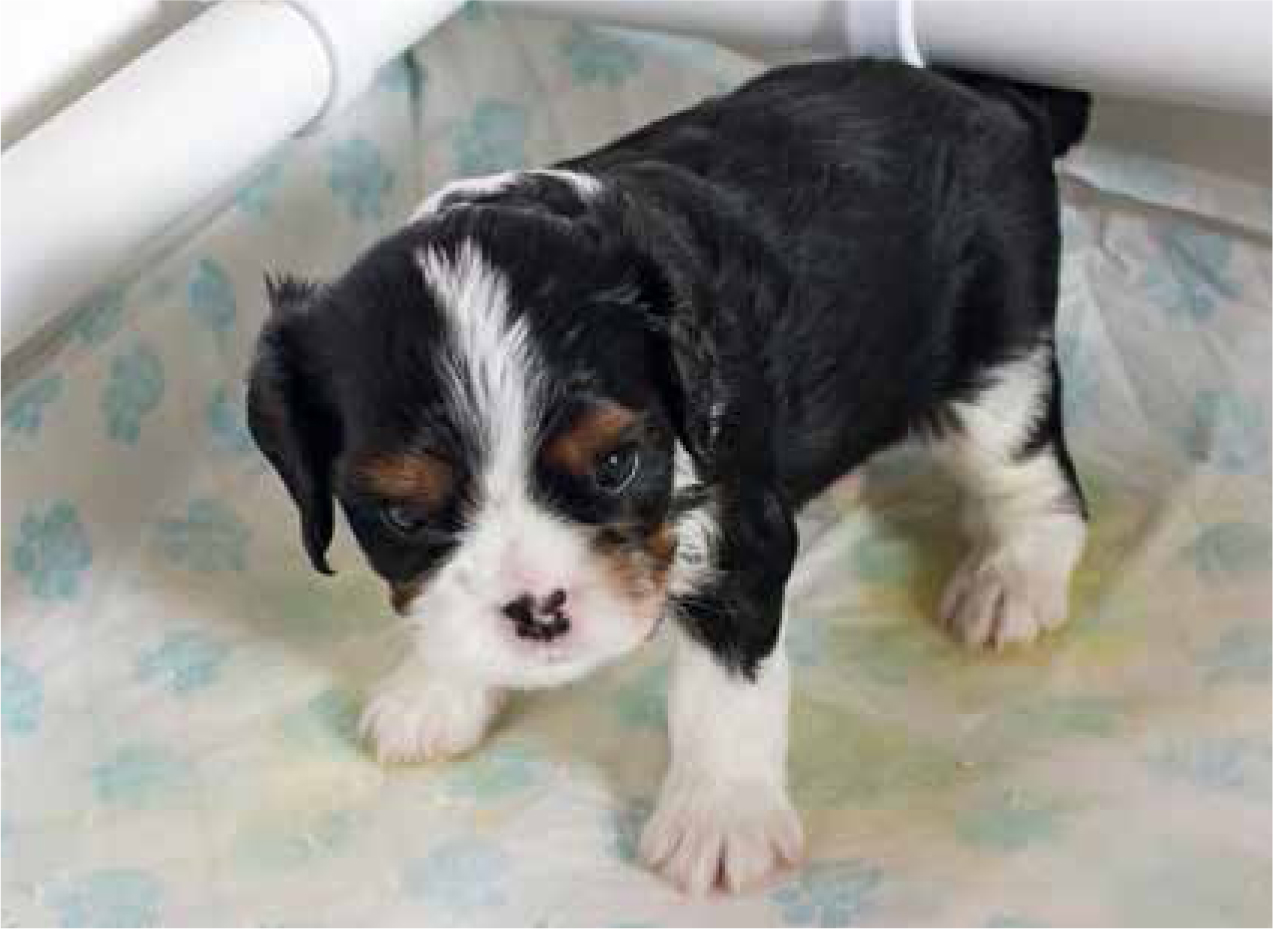
The socialisation or sensitive period — between 3 weeks and 12 weeks of age
During this time, puppies first learn how to interact with litter mates; and, by doing so, they learn to read canine body language, bite inhibition, and live in a social group. Second, puppies learn how to interact successfully with members of other species (McCune et al, 1995). Third, weaning begins and puppies learn how to cope with frustration when not fed on demand by the dam. Fourth, puppies should be exposed to wide-ranging sights, sounds, and sensory experiences. Lastly, puppies learn from positive experiences using positive reinforcement, so failing to provide their enriching environments will result in puppies becoming fearful, nervous adults or not being ‘fit for function’ as pets (Grandin and Deesing, 1998).
- Singleton puppies: these puppies are at risk of developing abnormal social behaviours related to poor social skills, lack of frustration control, and weaning distress unless exposed to dog role models or extra time with their breeder (Foyer, 2016) (Figure 3).
- Weaning: breeders should be encouraged to allow dams to wean their puppies gradually, as an abrupt separation may cause a great deal of stress for both dams and puppies who may develop weaning distress and other separation-related issues as adults (Serpell, personal communication) (Figure 4).
- Allowing the dam to have access to her puppies will ensure her intervention in rough play. Contrary to popular mythology, she does not grab, pin down, or shake her puppies by their scruff to ensure discipline (Figure 5).
- Teaching the puppies to cope on their own: removing one puppy from litter mates and the dam for time alone for 5 minutes and then increasing this time over the next 4 weeks. The breeder may use this time alone to play with or train the puppy using positive reinforcement, or allow the puppy to explore a new environment on his own without the dam or littermates. Individual crate training may begin at 7 weeks of age, by having two puppies together initially for nap time and overnight, separating the crate into two compartments, for toileting and/or sleeping. This may occur when puppies can see their littermates and dam, increasing to brief periods on their own in separate rooms.
- Socialisation to other dogs, and species: young puppies benefit from gentle encounters with a diverse group of people (Figures 6 and 7), and socially appropriate adult dogs (McCune et al, 1995).
- Environmental referencing: puppies may be taken outside, weather permitting. Common sense should prevail with the puppies taken to a safe and secure garden. If taken elsewhere, they should not be placed on the ground (Figure 8).
- Car journeys: by 6 weeks of age, puppies may be taken on car journeys. Initially, they are taken out together in a carry crate and eventually for individual journeys. When they reach their destination, the car door may be opened, and the carrier placed on the ground allowing the puppies opportunities to hear and see traffic going past. In order to prevent any stress or fear, desensitisation and counter-conditioning techniques are used.
- Preparation for vaccination and microchipping: to prepare puppies for their first vaccination at 6 weeks of age, they should be trained using positive reinforcement to welcome a mild restraint, holding the scruff of the neck and being on a table (Figure 9).
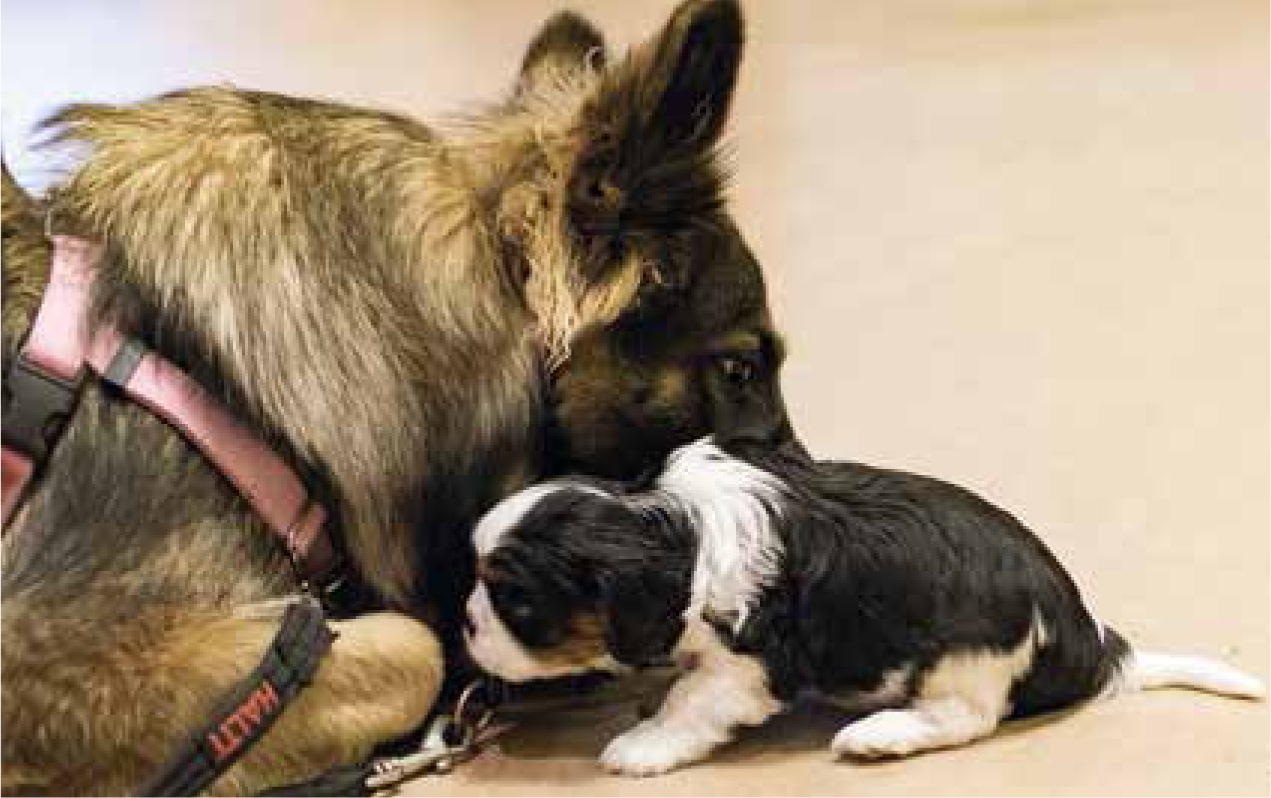
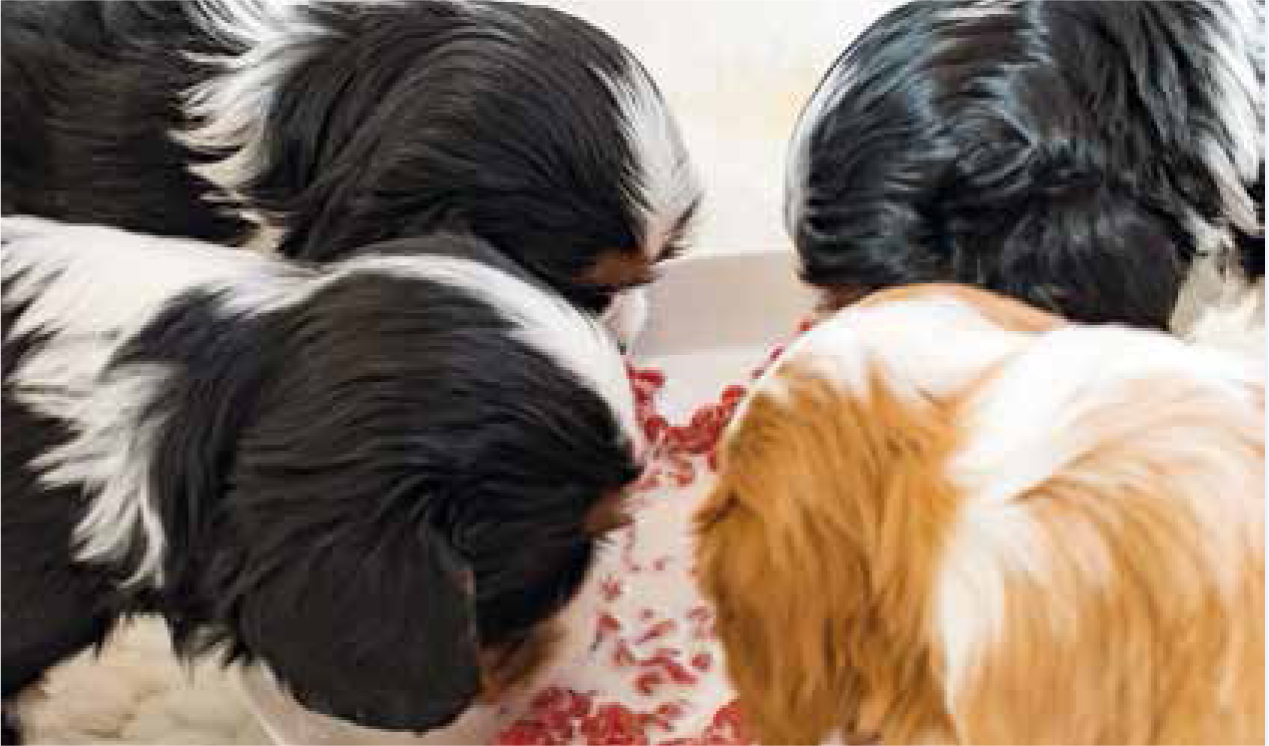
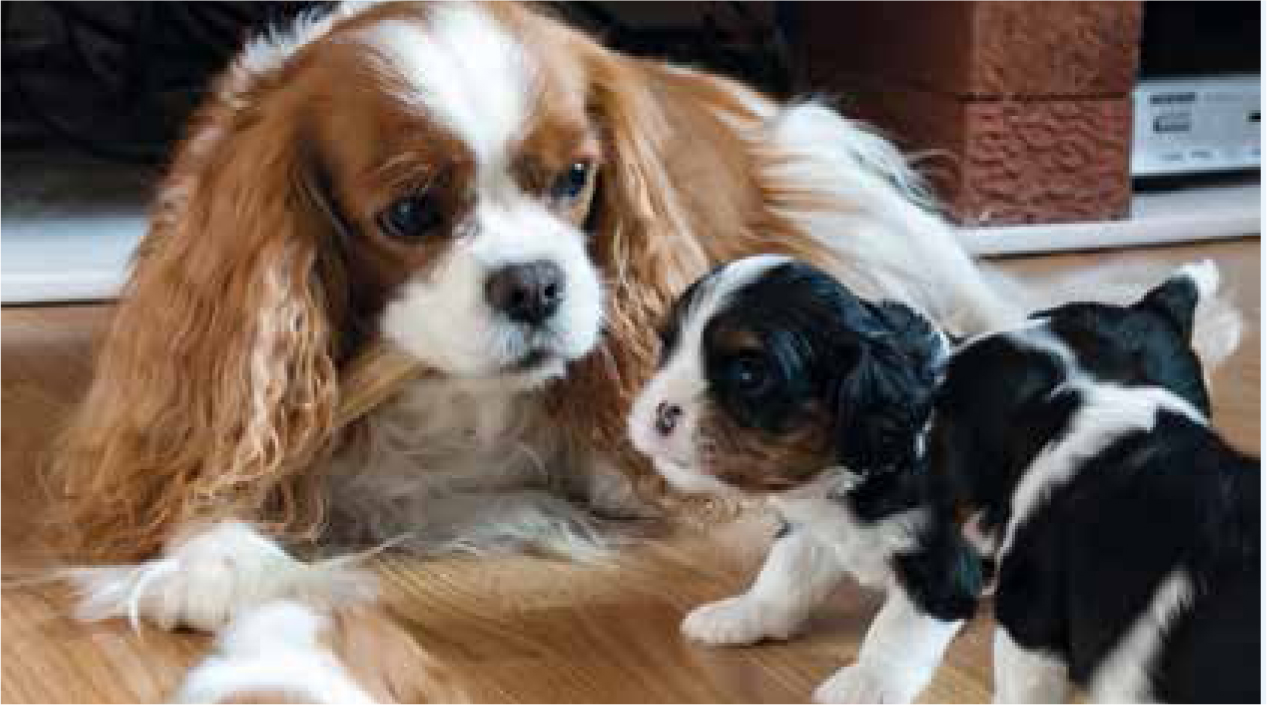
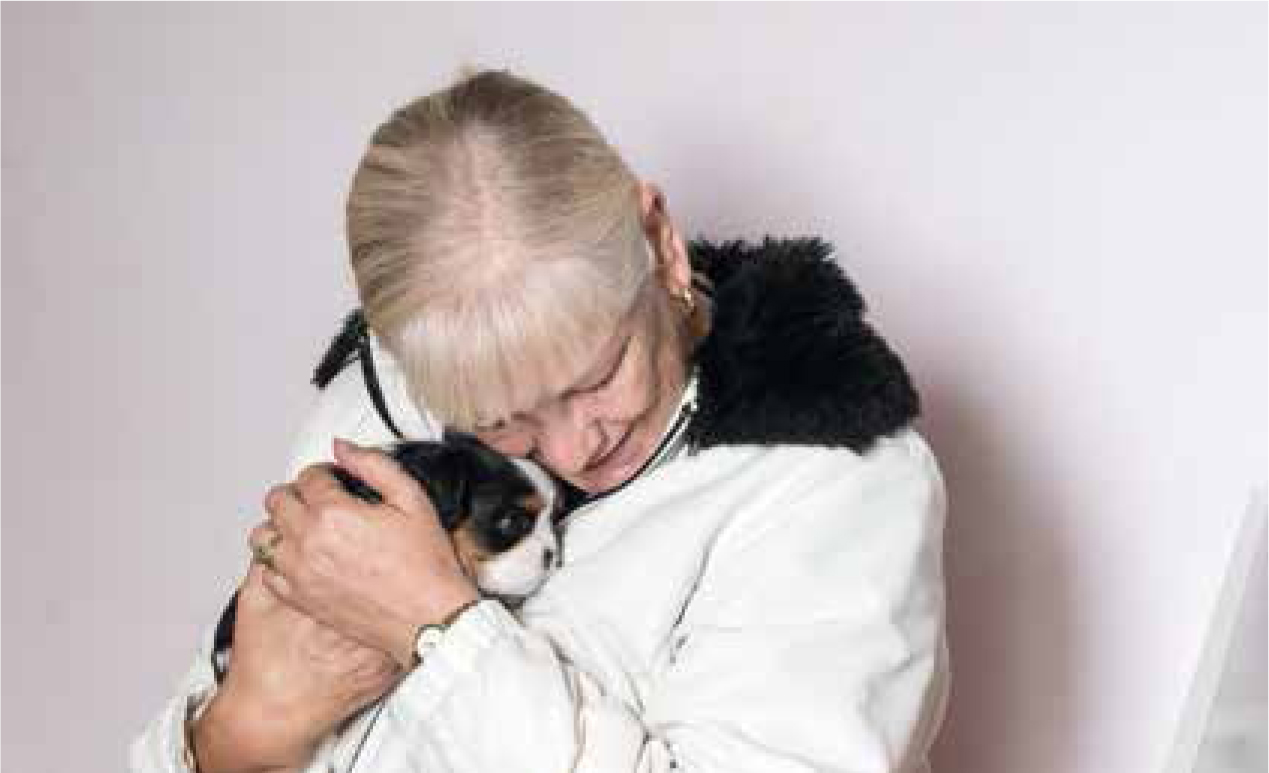
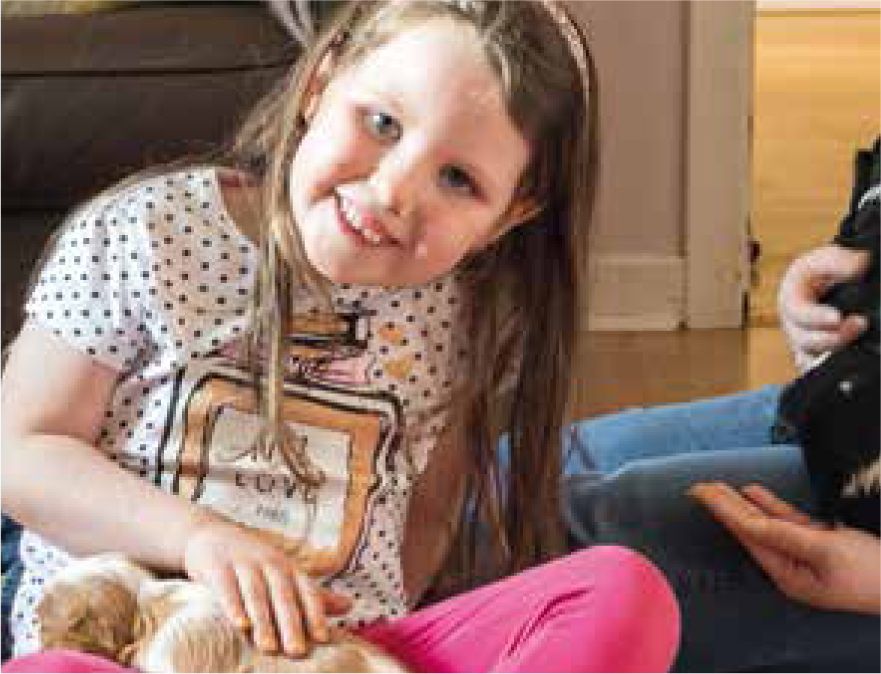
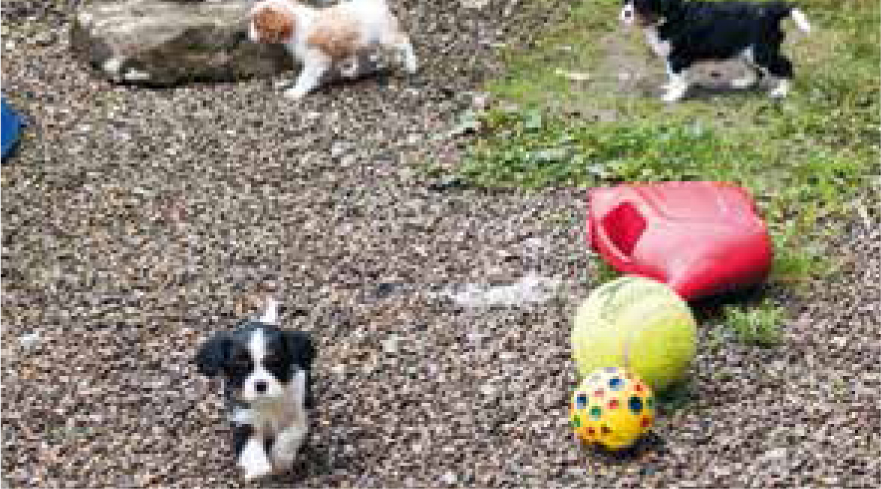
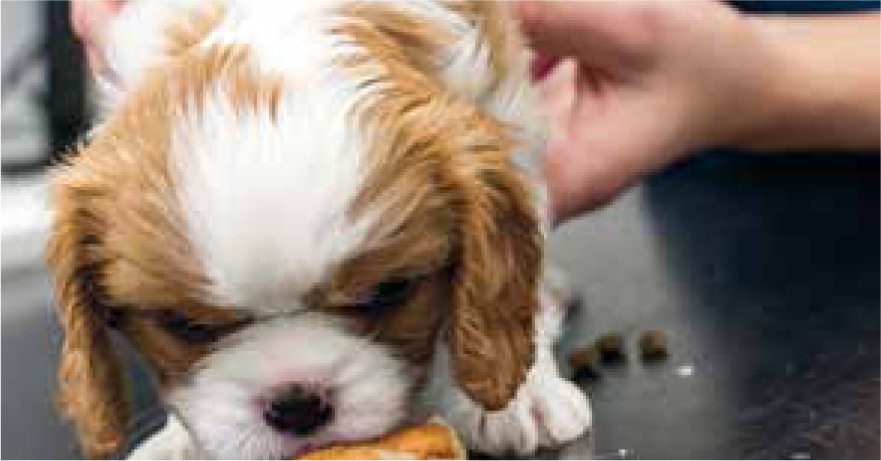
Conclusion
Many breeders breed for a purpose, such as having a litter from a much-loved pet, participating in a competition, or deriving income from puppy sales. But, whatever the motivation, the fact is that most dogs bred will become pets in a home, and conscientious breeders wish to breed physically healthy puppies, devoid of hereditary medical conditions. However, while breeding physically healthy puppies is one of the breeder's goals, another is the desire to breed puppies that are behaviourally and/or temperamentally sound as well. Toward that end, the RVN can play an important role in educating clients who wish to breed, or those who may accidentally be breeding, by giving them valuable information that will help to ensure that the puppies that they are breeding are ‘fit for purpose’.
Sources for further information
- Association of Pet Behaviour Counsellors (APBC): www.apbc.org.uk
- The Animal Behaviour and Training Council (ABTC): http://www.abtcouncil.org.uk/index/abtc-members-by-region.html
- Advisory Council on the Welfare Issues of Dog Breeding:
- http://www.dogadvisorycouncil.com/puppy/index2.html
- Blue Cross — Dog: https://www.bluecross.org.uk/pet-advice/choosing-right-dog
- Dogs Trust — Buying a Dog or a Puppy: https://www.dogstrust.org.uk/help-advice/advice-for-owners/buying-a-dog/buying-a-dog
- RSPCA Buying a puppy: https://www.rspca.org.uk/adviceandwelfare/pets/dogs/puppy
KEY POINTS
- Puppies may inherit undesirable behavioural traits from both the sire and dam.
- Breeders may influence environmental factors which have a great impact on the dog's future behaviour.
- Puppies go through stages of development, and breeders should be equipped with the knowledge to maximise positive behavioural outcomes during the stages.
- Special care should be given to puppies that are singleton, born by Caesarian or are orphaned, in terms of behavioural development.


